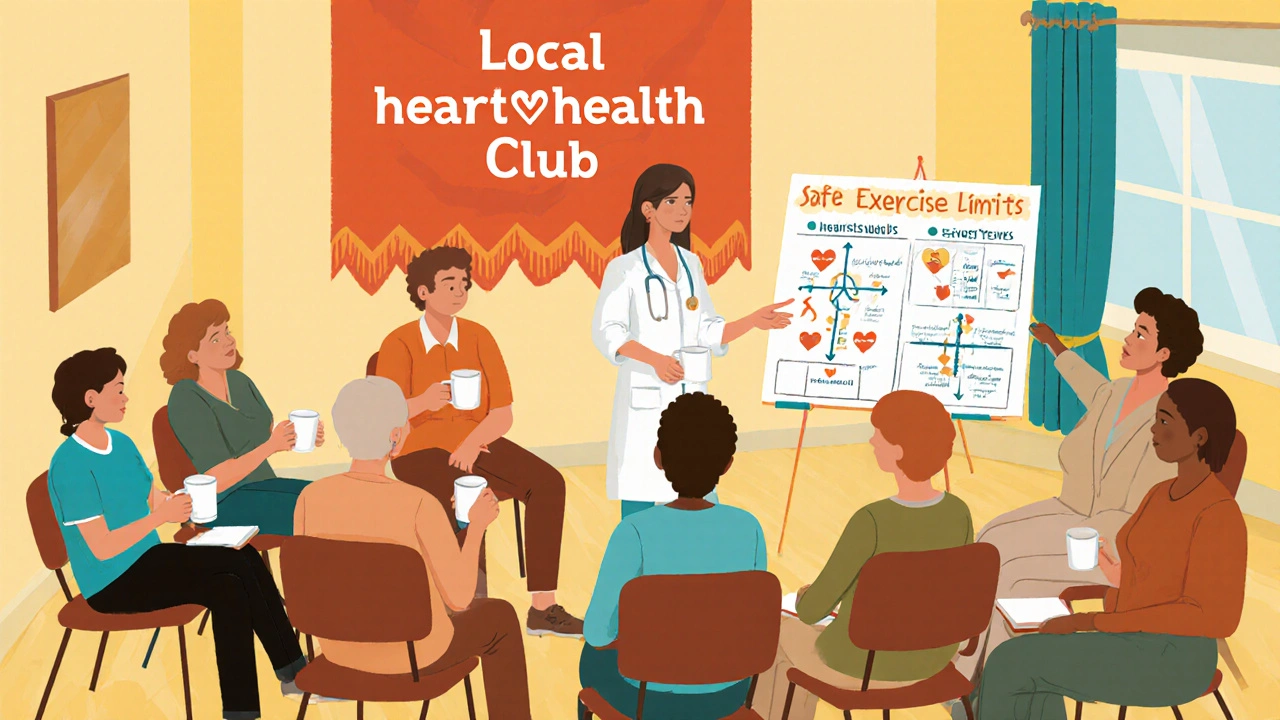HSS Education Checklist
After each cardiology visit, review the following topics and mark them as completed:
Connect with these resources to enhance your understanding and support network:
- Local Heart-Health Clubs: Attend monthly meet-ups for HSS patients and caregivers
- Online Forums: Join platforms like HCM Alliance or RareHeartTalk for peer advice
- Family Involvement: Include loved ones in medical appointments to assist with medication tracking
- Professional Counselors: Seek therapy for psychological stress related to chronic heart conditions
Track your symptoms to identify patterns and inform your healthcare team:
Quick Take
- Hypertrophic Subaortic Stenosis (HSS) narrows the left‑ventricular outflow, causing chest pain, fainting, and sudden death risk.
- Clear education reduces emergency visits and improves medication adherence.
- Support groups, family screening, and lifestyle tweaks help patients stay active safely.
- A simple checklist can guide conversations between clinicians, patients, and caregivers.
Understanding Hypertrophic Subaortic Stenosis
Hypertrophic Subaortic Stenosis is a heart muscle disorder where the septum thickens and blocks blood flow from the left ventricle to the aorta. The condition often appears in teens or early adulthood and can run in families because of inherited gene mutations. Typical symptoms include exertional shortness of breath, chest discomfort, and episodes of dizziness (syncope). When untreated, the narrowed outflow raises the chance of arrhythmias and sudden cardiac death.
Why Patient Education Saves Lives
When patients understand the mechanics of HSS, they become partners rather than passive recipients. Knowledge empowers them to recognize warning signs-like a sudden drop in exercise tolerance or unexplained palpitations-so they can seek care before a crisis. Studies from cardiology centers in 2023 show that educated patients have a 30% lower hospitalization rate for HSS‑related events. Moreover, educated families are more likely to pursue genetic testing, catching at‑risk relatives early.

Core Topics Every Patient Should Know
The following list covers the essential information you should discuss with your cardiologist or heart‑failure nurse:
- What the disease does: How septal thickening impacts blood flow and why it can cause fainting.
- Symptoms to watch for: Chest pain, shortness of breath, light‑headedness, and irregular heartbeats.
- Diagnostic tools: Echocardiogram, cardiac MRI, and genetic panels.
- Medication basics: Beta‑blockers, calcium channel blockers, and anti‑arrhythmic drugs-their purpose, dosing, and side‑effects.
- Procedural options: Surgical myectomy, alcohol septal ablation, and when each is recommended.
- Lifestyle adjustments: Safe exercise thresholds, hydration needs, and avoiding extreme temperature changes.
- Family screening: Who should get genetic testing and how often follow‑up echo is needed.
- Emergency plan: When to call emergency services, how to describe your condition, and what medications to carry.
Building a Support Network
Patient education works best when reinforced by a community. Consider these channels:
- Local heart‑health clubs: Many hospitals host monthly meet‑ups for HSS patients and caregivers.
- Online forums: Platforms like the HCM Alliance or RareHeartTalk provide peer‑to‑peer advice and real‑world tips.
- Family involvement: Invite spouses, parents, or siblings to appointments; they can help remember medication schedules.
- Professional counselors: Psychological stress is common; a therapist familiar with chronic cardiac conditions can reduce anxiety.
Practical Steps for Patients and Caregivers
Use the checklist below after each cardiology visit. Tick off each item before the next appointment.
| Topic | Resource | Action |
|---|---|---|
| Understanding the obstruction | Printed handout from clinic | Read and highlight key points. |
| Medication management | Medication app (e.g., Medisafe) | Set daily reminders. |
| Genetic testing | Genetic counselor referral | Schedule a 30‑minute session. |
| Exercise limits | Cardiac rehab program | Attend weekly supervised session. |
| Emergency plan | Personalized card | Carry in wallet at all times. |
Additional tips:
- Keep a symptom diary-date, activity, and how you felt.
- Ask your doctor to explain any jargon; write down the definition.
- Review the checklist with a trusted family member before each visit.
Common Pitfalls and How to Avoid Them
Even motivated patients can slip into habits that worsen outcomes. Watch out for:
- Skipping doses: Set alarms, use pill organizers, and involve a caregiver.
- Over‑exertion: Follow the "talk test" during exercise-if you can’t hold a conversation, you’re likely over‑doing it.
- Ignoring genetic advice: Skip screening and you may miss a sibling who needs early intervention.
- Relying on myths: Online anecdotes about “miracle cures” often lack scientific backing; verify with your cardiology team.

Frequently Asked Questions
Can I exercise safely with Hypertrophic Subaortic Stenosis?
Yes, but the intensity matters. Low‑to‑moderate aerobic activity-like brisk walking, stationary cycling, or swimming-keeps the heart healthy without stressing the outflow tract. Always get clearance from your cardiologist and use the "talk test" to gauge effort.
What should I do if I feel a sudden dizzy spell?
Stop what you’re doing, sit or lie down, and call emergency services. Mention that you have Hypertrophic Subaortic Stenosis; this helps responders prioritize cardiac monitoring.
Is surgery the only cure?
Surgical myectomy or alcohol septal ablation can relieve obstruction, but many patients manage well with medication and lifestyle changes. Treatment choice depends on symptom severity, septal thickness, and personal health goals.
Should my children be tested?
Because HSS often runs in families, genetic counseling is recommended for first‑degree relatives. A simple echo or genetic panel can spot early changes before symptoms appear.
What role does diet play?
A heart‑healthy diet-rich in fruits, vegetables, whole grains, lean protein, and low in sodium-supports overall cardiac function. Stay well‑hydrated, especially if you’re on diuretics, but avoid extreme electrolyte shifts.
By staying informed, leaning on a supportive community, and following a clear action plan, patients with Hypertrophic Subaortic Stenosis can live active, fulfilling lives while keeping risks in check.

Comments (5)
Rebecca Bissett
October 3, 2025 AT 22:22
When you first hear the term Hypertrophic Subaortic Stenosis, your heart races with anxiety!!!
But knowledge is the antidote, a shining beacon that cuts through the fog of fear!!!
Understanding how the septum thickens empowers you to ask the right questions, to demand clarity, and to take control!!!
These checklists act like lifelines, reminding you to discuss obstruction, medication, and genetics at every appointment!!!
Imagine walking into a cardiology visit with a printed handout; you feel prepared, confident, and heard!!!
Families who join the conversation become allies, noticing subtle symptom changes that might otherwise slip by!!!
Support groups whisper reassurance, turning isolation into shared stories of triumph!!!
The emergency plan you create can be the difference between a quick call to 911 and a tragic outcome!!!
Studies show a 30% drop in hospitalizations when patients are educated, a statistic that sings hope!!!
Every pill you take, when you understand its purpose, becomes a deliberate act of self‑care!!!
Exercise limits, once a mystery, become clear guidelines that keep you active without risking collapse!!!
Genetic testing, far from a scary label, is a gift you can pass to siblings and children, sparing them from hidden danger!!!
Even the simplest habit-keeping a symptom diary-creates a narrative your doctor can read like a map!!!
So take this checklist, mark each item, and wear it as armor in your daily battle!!!
Your heart may be challenged, but with education you become the hero of your own story!!!
Michael Dion
October 13, 2025 AT 05:59
Looks solid but kinda boring.
Trina Smith
October 22, 2025 AT 13:35
The article hits the key points nicely 😊.
It reminds me that education is a partnership, not a lecture.
The checklist format is practical for busy patients.
I also like the nod to cultural community resources, which can be a lifeline.
Keep spreading the word 🌍.
josh Furley
October 31, 2025 AT 21:12
Sure, education sounds great, but if you’re already overwhelmed, adding more checklists may just create paperwork fatigue.
The term “septal obstruction” is jargon that trips laypeople.
Still, a clear glossary can bridge that gap.
🤔
Jacob Smith
November 10, 2025 AT 04:49
Yo, this checklist is lit!
Keep that med schedule on point, use an app like Medisafe so you don’t miss a dose.
Don’t forget to grab a buddy to fam and go to the cardio appt together.
You got this, just stay on track!